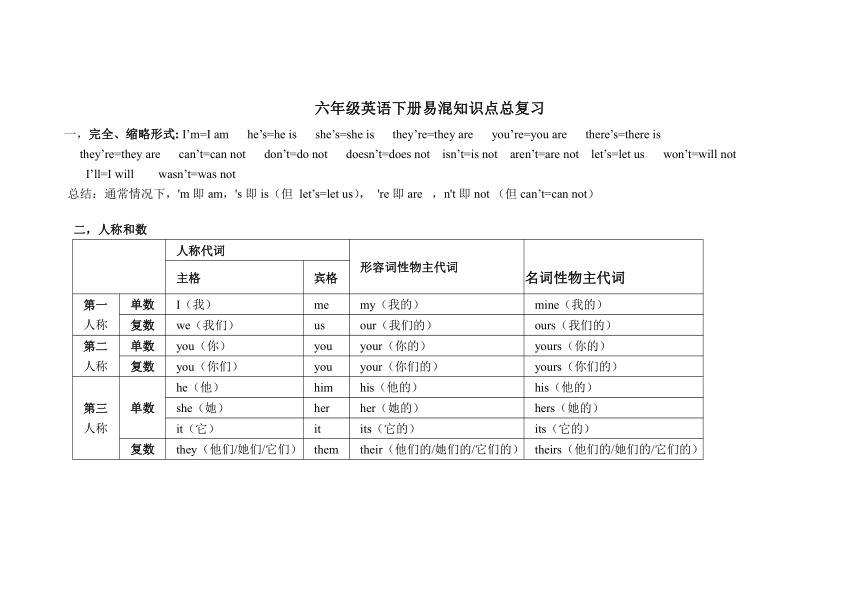
六年级英语下册易混知识点总复习 完全、缩略形式: I’m=I am he’s=he is she’s=she is they’re=they are you’re=you are there’s=there is they’re=they are can’t=can not don’t=do not doesn’t=does not isn’t=is not aren’t=are not let’s=let us won’t=will not I’ll=I will wasn’t=was not ?总结:通常情况下,'m即am,'s即is(但 let’s=let us), 're即are? ,n't即not?(但can’t=can not) 二,人称和数 人称代词 形容词性物主代词 主格 宾格 名词性物主代词 第一 人称 单数 I(我) me my(我的) mine(我的) 复数 we(我们) us our(我们的) ours(我们的) 第二 人称 单数 you(你) you your(你的) yours(你的) 复数 you(你们) you your(你们的) yours(你们的) 第三 人称 单数 he(他) him his(他的) his(他的) she(她) her her(她的) hers(她的) it(它) it its(它的) its(它的) 复数 they(他们/她们/它们) them their(他们的/她们的/它们的) theirs(他们的/她们的/它们的) 六:句型归类 肯定句:是指用肯定的语气来陈述的句子,如: I’m a student. She is a doctor. He works in a hospital. There are four fans in our classroom. He will eat lunch at 12:00. I watched TV yesterday evening. 2、否定句:含有否定词或表示否定意义词的句子,如:I’m not a student. She is not (isn’t) a doctor. He does not (doesn’t) work in a hospital. There are not (aren’t) four fans in our classroom. He will not (won’t) eat lunch at 12:00. I did not (didn’t) watch TV yesterday evening. 注意 小结:否定句主要是在肯定句的基础上加上了否定词 “not”。有动词be的句子则“not”加在be后面,可缩写成“isn’t,aren’t”,但am not 一般都分开写。没有动词be的句子则要先在主要动词的前面加上一个助动词(do,does,did),然后在它后面加上“not”,你也可以把它们缩写在一起如“don’t , doesn’t , didn’t )。这三个助动词要根据人称和时态来选择,其中“does”只用于一般现在时主语是第三人称单数的情况,而“did”只用于一般过去时,不论主语是什么人称和数,都用“did” 。 3、一般疑问句:是指询问事实的句子,此类句子必须用“yes”,或“no”来回答。 如:Are you a student? Yes, I am / No, I’m not. Is she a doctor? Yes, she is. / No, she isn’t. Does he work in a hospital? Yes, he does. / No, he doesn’t. Are there four fans in our classroom? Yes, there are. / No, there aren’t. Are you going to buy a comic book tonight? Yes, I am. / No, I am not. (Yes, we are. / No, we aren’t.) Will he eat lunch at 12:00? Yes, I will. / No, I will not(won’t). Are they swimming? Yes, they are. / No, they aren’t. Did you watch TV yesterday evening? Yes, I did. / No, I didn’t. 注意 小结:一般疑问句是在肯定句的基础上, ①把动词be调到首位,其他照写,末尾标点符号变成问号即可。 ②没有动词be的句子则要在句首加上一个助动词(do,does,did)再把紧跟在后面的动词变回原形,末尾标点符号变成问号即可。 这三个助动词也要根据人称和时态来选择,其中“does”只用于一般现在时主语是第三人称单数的情况,而“did”只用于一般过去时,不论主语是什么人称和数,都用“did” 。一般疑问句有个重要的原则就是问和答要一致,即问句里的第一个单词(助动词)和简略答句里的这个词是一致的。 4、特殊疑问句:以特殊疑问词(what , where , who , which , when , whose , why , how等)开头引导的 ... ...
~~ 您好,已阅读到文档的结尾了 ~~

